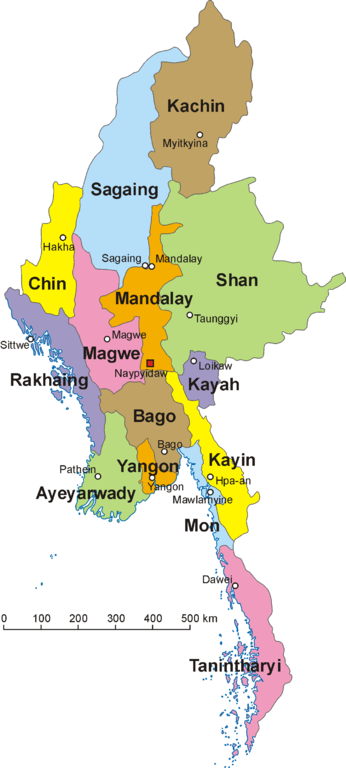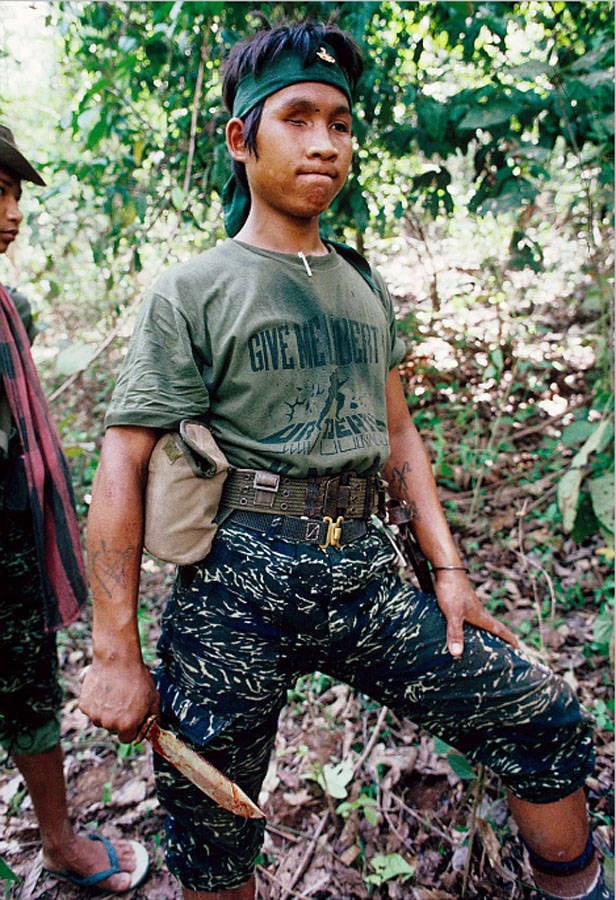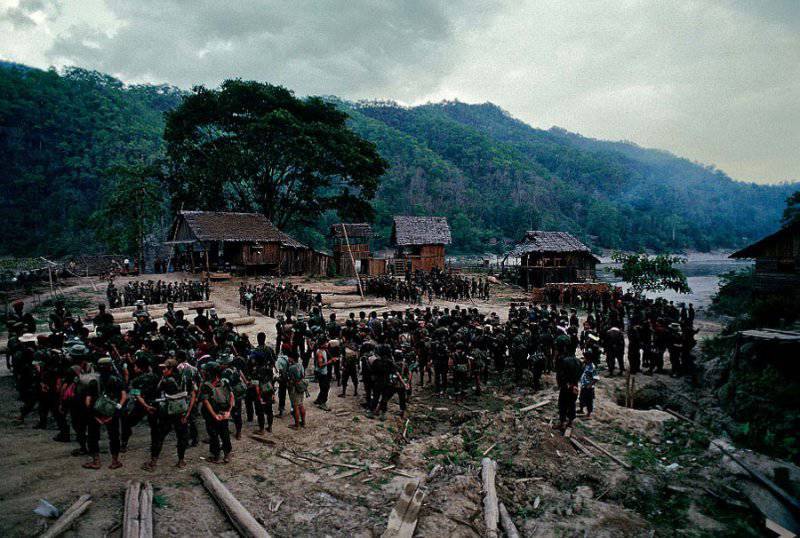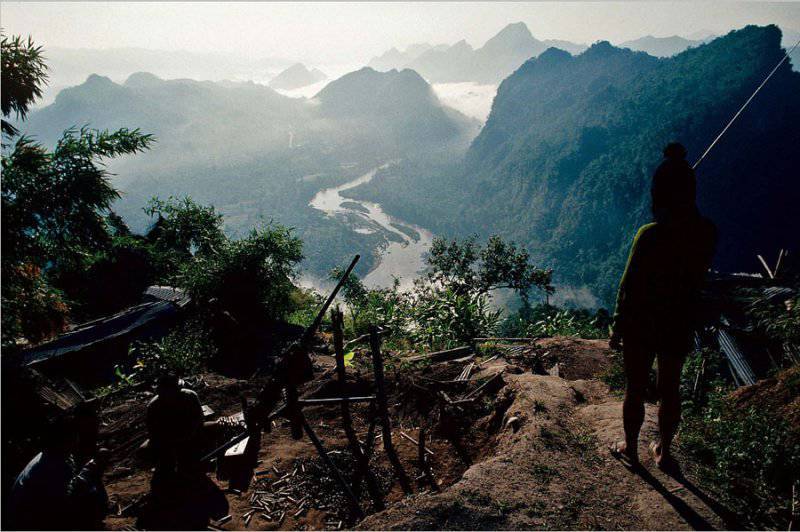Burma Civil War: Communists vs. Government - Red and White Flags
The civil war in Burma is little known to the average Russian. Only experts and amateur historians, yes, perhaps, those who have watched and remembers the movie “Rambo-4” have an idea about the events, which will be discussed below. Meanwhile for all of us story This civil war is an example of what a state that is located at the intersection of interests of the most diverse powers, possessing certain natural resources, and, at the same time, not distinguished by political and social stability, can grasp.
In the second half of the twentieth century, during the so-called The “cold war”, Indochina, became an important space for military-political activity. Even before the beginning of the Second World War, communist and national liberation parties and movements began to form in the Asian colonies of the European powers, under the influence of the Soviet Union. The victory in the Second World War, which in Southeast Asia had the character of a bloody confrontation between the Japanese imperial army and the anti-fascist coalition represented by British, Australian, American troops, led to the strengthening of the positions of national liberation movements throughout the world.
Naturally, the winning moods affected also Indochina. In its eastern part - Vietnam, and then Laos - the national liberation movement ultimately ended with the victory of the communists, the American military aggression, the victory over the American troops and their allies and the establishment of socialist regimes that exist with certain adjustments of the political and economic course present tense. Cambodia survived the "Polpotovsky experiment." Royal Thailand, which had never been in the status of anyone's colony and maintained state sovereignty throughout history, became a loyal ally of the United States. But Burma - the most western and in many ways the most closed country of the Indochinese Peninsula - for many decades it has become a place of clash of interests of various forces. What caused a long civil war in the territory of the country, some centers of which have not been eliminated until the present time.
 Since 1989, the country has abandoned the name "Burma", which has been popular outside of it, and for the last twenty-five years it has been called "Myanmar". But for the convenience of our readers, we will use in this article its old and usual name. All the years of its post-war independent (from British colonialists) existence are the years of the government of successive authoritarian regimes and incessant civil war.
Since 1989, the country has abandoned the name "Burma", which has been popular outside of it, and for the last twenty-five years it has been called "Myanmar". But for the convenience of our readers, we will use in this article its old and usual name. All the years of its post-war independent (from British colonialists) existence are the years of the government of successive authoritarian regimes and incessant civil war. Representatives of several dozen nations and tribal groups live in this relatively large state (55 million). Although for the average European or American, they are all “on one person”, in fact, between them there are very serious differences in language, in religion, and in the characteristics of culture and management. Bye Burma from 1885 to 1945 was under the control of the British crown, English politicians managed to maneuver between the contradictions of numerous ethnic groups of the country and build a fairly viable management system. Japanese occupation of Burma in 1942-1945 and its subsequent liberation from the British protectorate, entailed the aggravation of previous offenses.
Post-war Burma began its history as a federal state - the Union of Burma, which included seven provinces inhabited predominantly by Burmese (Myanmar) and seven national states (Shan, Chin, Mon, Kaya, Karen, Kachin and Arakan). Naturally, from the first days of the independent existence of the state, the political situation in it destabilized. The catalyst was the promise of the leaving British colonialists to grant state independence to several territories densely populated by national minorities - the states of Shan, Karen and Kaya. The nationalities of other states were also connected, and it also seemed to them that in Burmese Burma their national rights and interests would be greatly affected.
The central power of post-war Burma was represented by “national” socialists from the Anti-Fascist League of People’s Freedom (hereinafter - the ALNS). This organization, which inherited the traditions of pre-war national liberation parties and societies (“Dobama Asiyon” and others), was based on the principles of “Burmese socialism”, which, however, did not duplicate the Marxist-Leninist concept, but offered its own model of reforming economic, social and political life country.
The first leader of the ALNS was Aung San, the legendary Burmese revolutionary who was killed by terrorists in 1947 year and is a well-known Russian-speaking reader on the biography, published in the “Life of Remarkable People” series by Igor Mozheiko. For eleven years, the ALNS (from 1947 to 1958) was headed by U Nu, one of the few Burmese politicians who are well known to the average Russian-speaking older man thanks to his friendship with the Soviet Union.
Having established itself in power, the government of U Nu embarked on an economic reform aimed at the gradual transformation of Burma into a prosperous socialist country. However, by this time the social situation in the country had deteriorated significantly, which was to blame, including the impoverishment of Burmese peasants due to the predatory actions of Hindu usurers. Among the poor peasants in the lower part of the country, the Communist Party of Burma, which offered a more radical program of action, gained significant influence. Already in the 1948 year, shortly after the country's independence was declared, clashes began between government forces and armed detachments of the Communist Party of Burma.
It is worth noting that by this time the Communist Party of Burma had split into two parts - simply the Communist Party, also called the “White Flag” party, and the Communist Party of the Red Flag. The latter was considered more radical and occupied irreconcilable positions, although in the armed confrontation with the Burmese authorities participated the military formations of both factions of the Burmese Communist Party. It turned out that the "Red Flag", accused by opponents of Trotskyism, entrenched in the west of the country, in the province of Arakan, and Lower Burma, and then the northern and eastern provinces of the state, became the arena of the White Flag activity, reorienting to Maoism.
Despite all the efforts of the Soviet Union and the international communist movement to prevent a war between the socialists and the communists, it was becoming increasingly fierce. An important role was played by the split of the communist movement, part of which went for China. For obvious reasons, in Southeast Asia, the positions of the Chinese Communist Party, which adopted the doctrine of Maoism, turned out to be very strong. It was precisely because of the pro-Chinese orientation that the Soviet Union did not render the Communist Party of Burma the support that, say, the Vietnamese Communists received.
The initial success of the Communists in the civil war was largely due to the support they enjoyed among the peasant population of Lower Burma. Promising to endow the peasants with land and overcome the exploitation of Indian usurers, the Communists attracted the sympathy of not only the rural population, but also many soldiers mobilized into government forces, who deserted in whole groups and went over to the rebels.
And, nevertheless, by the middle of 1950's, the activity of the communists began to gradually subside, largely due to organizational squabbles and the elementary inability of the communist leaders to negotiate with each other and with other key actors of the armed confrontation in the country — first all over, with ethnic formations in national states.
In 1962, General Ne Win came to power in Burma. A veteran of the Army of Independence of Burma, he received military education in the Second World War in Japan, with whom the “takins” (fighters for the independence of Burma) then worked closely together. After the Takin’s transition to anti-Japanese positions, the end of World War II and the proclamation of independence, Ne Win consistently held senior positions in the armed forces of sovereign Burma until he was appointed Prime Minister in 1958 and made a coup d'état in 1062.
The political platform of Not Vina, like U Nu, was based on socialist principles, but unlike the predecessor, the general did not fail to bring them to life. The whole industry of Burma was nationalized, agricultural cooperatives were created, opposition political parties were banned. The new leader of the country took decisive measures against the communist rebels. The armed units of the Communist Party suffered several serious defeats, after which they were forced to retreat to the remote northern areas of the country inhabited by national minorities, and go to the classic guerrilla war.

Unlike Ne Win, who occupied important posts, his peer and former comrade in the national liberation movement, Takin Tan Tun, after the end of World War II, went into a deaf opposition. It was he who headed the Communist Party of Burma (White Flag) and for twenty years spent in the jungle, led its combat operations against the central government of the country. British researcher Martin Smith calls Takina Tan Tuna second in importance after Aung Sana’s leader of the national liberation movement in Burma, emphasizing his level not only as an organizer and leader, but also as a theoretical worker.
Takin Tan Tun and his supporters supported the Chinese line in the international communist movement, accusing the Soviet Union and the CPSU of supporting the semi-colonial nationalist regime of Ne Win. Naturally, the actions of the Maoist Communist Party were beneficial to China, which acquired a conductor of its influence in Burma and West Indochina as a whole. At the same time, the reorganization of the Communist Party began in the Chinese way, accompanied by the creation of a school of political training and the conduct of its own "cultural revolution" in order to cleanse the party of "revisionists." As a result of this “cultural revolution” large-scale purges were carried out in the party, which also concerned its leaders. At the same time, according to the Maoist rule, the number of executors of sentences included friends and even sons or brothers of “traitors of the party line” sentenced to death.
In 1968, Takin Tan Tun was killed by one of his militants. Domestic purges and ongoing operations by government forces have also led to a significant reduction in the scope of the PBC. The party, which suffered serious losses, was forced to concentrate its activities in the areas inhabited by national minorities, primarily in the Wa area.
The ideological line of the Communist Party remained Maoist. In 1978, the new party leader, Takin Ba Thein Tin, described the Soviet policy as imperialistic and Vietnam as hegemonic, wholly supporting Cambodian Khmer Rouge. The “people's war”, based on the rebel potential of the villages, was viewed as the main tactical line of the communists at the present stage of the confrontation.
As China’s political course was being liberalized, its numerous satellites — the Communist Parties of Southeast Asia — were losing their real positions in their countries. The weakening of the Burmese Communist Party, which followed in the 1980s, was largely due to a reduction in Chinese aid, although at the same time, the specifics of ethnic and social relations in the Burmese provinces, the skillful policy of the central leadership that combined military operations with truces with the leaders should not be understated. national minorities.
At present, the communist partisans in Burma do not have even the slightest influence they used before, and certainly they cannot be compared in scale with the like-minded people in the not-so-distant Philippines. However, according to reports of the Burmese and British media, if there are certain social grounds, the Communist Party of Burma is able to resume its combat activity.
Thus, we see that the communist insurgency in Burma, which for several decades was one of the key problems of the central government, reduced its activity with the de-radicalization of China’s senior partner. Today, the Chinese government is more inclined to use economic leverage, rather than support radical formations in neighboring countries. As for the Soviet Union, in the case of Burma, he suffered a clear political fiasco. The military regime was quite closed, including for the expansion of Soviet ideology, and the ability to influence it by controlling the activities of the Communist Party was lost at the end of the 1940-s, since the Union reoriented itself to the support of the socialist government of U Nu.
The Americans and the British turned out to be more far-sighted players in Burmese politics, using the activities of nationalist movements of ethnic minorities to fulfill their strategic interests. But this is another story, about which - in the following material.
P P 'SЊSЏ RџRѕR "RѕRЅSЃRєRёR№
- P P 'SЊSЏ RџRѕR "RѕRЅSЃRєRёR№
- Bruce Haley


Information